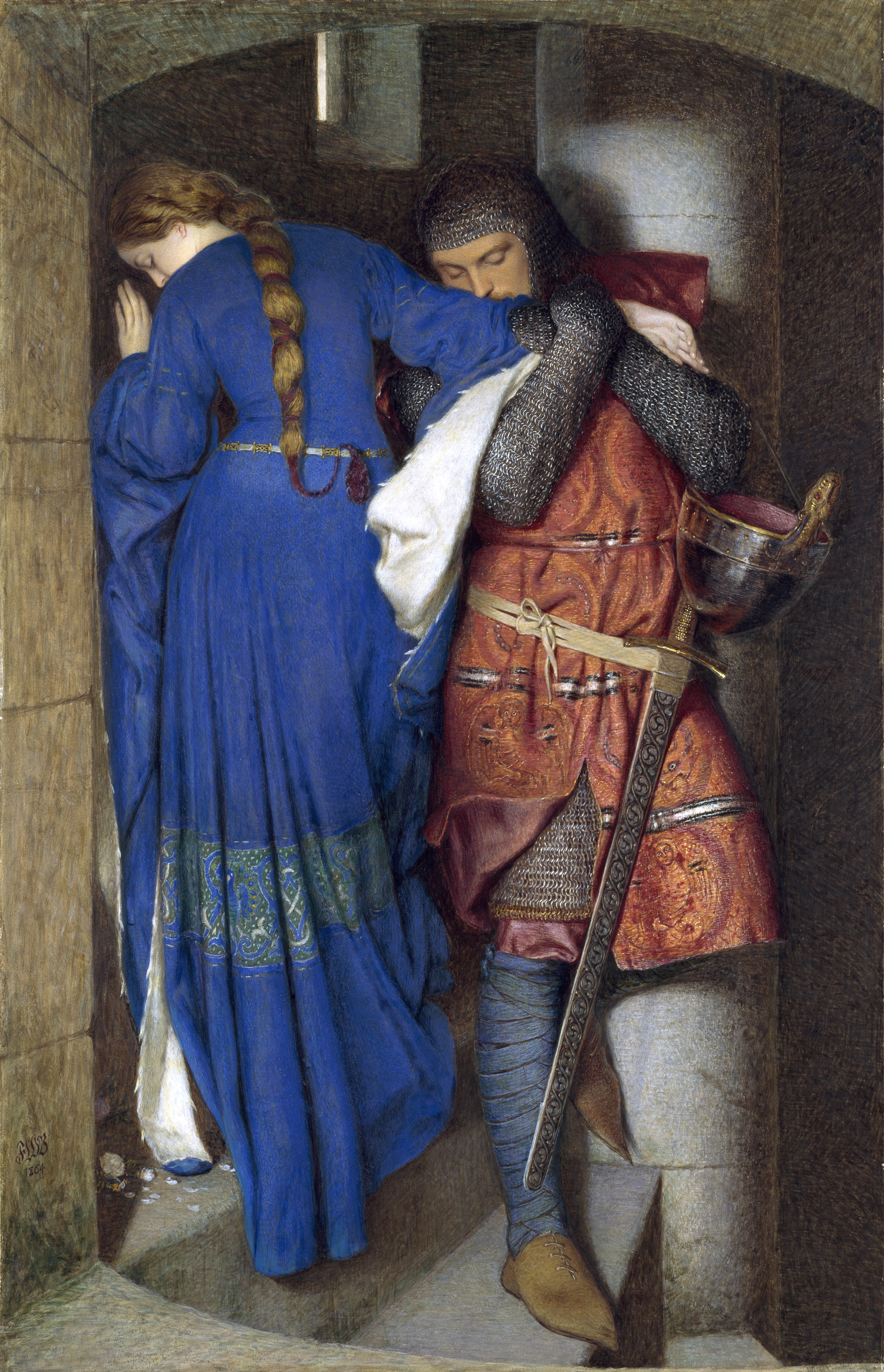 Frederic William Burton (1816-1900), 'Hellelil and Hildebrand, the Meeting on the Turret Stairs', 1864. Photo, National Gallery of Ireland.
Frederic William Burton (1816-1900), 'Hellelil and Hildebrand, the Meeting on the Turret Stairs', 1864. Photo, National Gallery of Ireland.

Self-guided tour for children and families
Take a look at some of our works through a very different lens and discover some of the hidden stories they can tell. We hope that these artworks will encourage families to explore and chat together on your visit to the Gallery. We have chosen very different works, from different times, in various styles, so that there is lots to discover. Questions in each entry will help to get everyone using their imagination and looking more closely.
Want to learn more? Follow the links for more information about each artwork and other related projects. For more themes, check out the Through a Lens collections.
Enjoy!
Finding your way around
- If you are doing this tour onsite at the Gallery, taking in all the works will take approximately 45 minutes.
- Feel free to skip a few or spend longer at others.
- The works are listed in the order they appear in the Gallery if you enter from Merrion Square.
- When in the Gallery, please be aware that you will be moving across various levels, which may require access to lifts. You can ask any member of staff to direct you to the closest lift.
- They will also be able to direct you to any other facilities you may require including a Changing Places facility located close to the Merrion Square entrance. If you need them, we have nappies of various sizes available for visitors as well.
Start the tour!
 Frederic William Burton (1816-1900), 'Hellelil and Hildebrand, the Meeting on the Turret Stairs', 1864. Photo, National Gallery of Ireland.
Frederic William Burton (1816-1900), 'Hellelil and Hildebrand, the Meeting on the Turret Stairs', 1864. Photo, National Gallery of Ireland.
Room 20
Frederic William Burton, (1816-1900), Hellelil and Hildebrand, the Meeting on the Turret Stairs, 1864
On view: Thursdays 11.30am–12.30pm and Sundays 2pm–3pm
This painting tells a tragic story.
- What do you think is happening?
- What do you think will happen next?
This story is from a medieval Danish ballad. In the ballad the princess Hellelil falls in love with her personal guard Hildebrand. Her father doesn’t approve of the relationship and orders her seven brothers to kill the young prince! But instead Hildebrand kills Hellelil’s brothers, with the exception of the youngest, who Hellelil asks him to spare. This story has a sad ending as Hildebrand dies of his wounds.
There is a lot of action in this story, but the artist has chosen not to show any fighting.
- Why do you think he has left it out?
- The two people are facing different directions, why do you think that is?
- Does this staircase look like a comfortable place to meet?
- How do you think Hellelil and Hildebrand feel in this moment?
In the Gallery this painting is in a very dark room.
- Can you guess why?
- How does the darker space make you feel?
- If you are at home, why not pull the curtains or turn off the lights to look at the painting! How does it feel?
Frederic William Burton mostly used watercolour and gouache when he painted. Watercolour is very sensitive to light and fades over time if exposed to too much light. The Gallery has a big collection of watercolours but most of the works on display are made of oil paint because oil paint is less sensitive to light. This painting is in a very special cabinet, with doors that can close and block out all the light. The Gallery only opens the cabinet for 2 hours a week!
In the Gallery or at home
Get a pencil and some paper to create your own story based on this painting! What way will you tell your story?
- Will you make a comic strip of the adventure?
- Or will you write the tale, you could start the story with once upon a time?
- Would you like to say the story out loud, and take it in turns to make it up a line at a time with the person you’re with?
Explore further
Download a colouring sheet of this painting
At home creative challenge: A Colour Experiment!
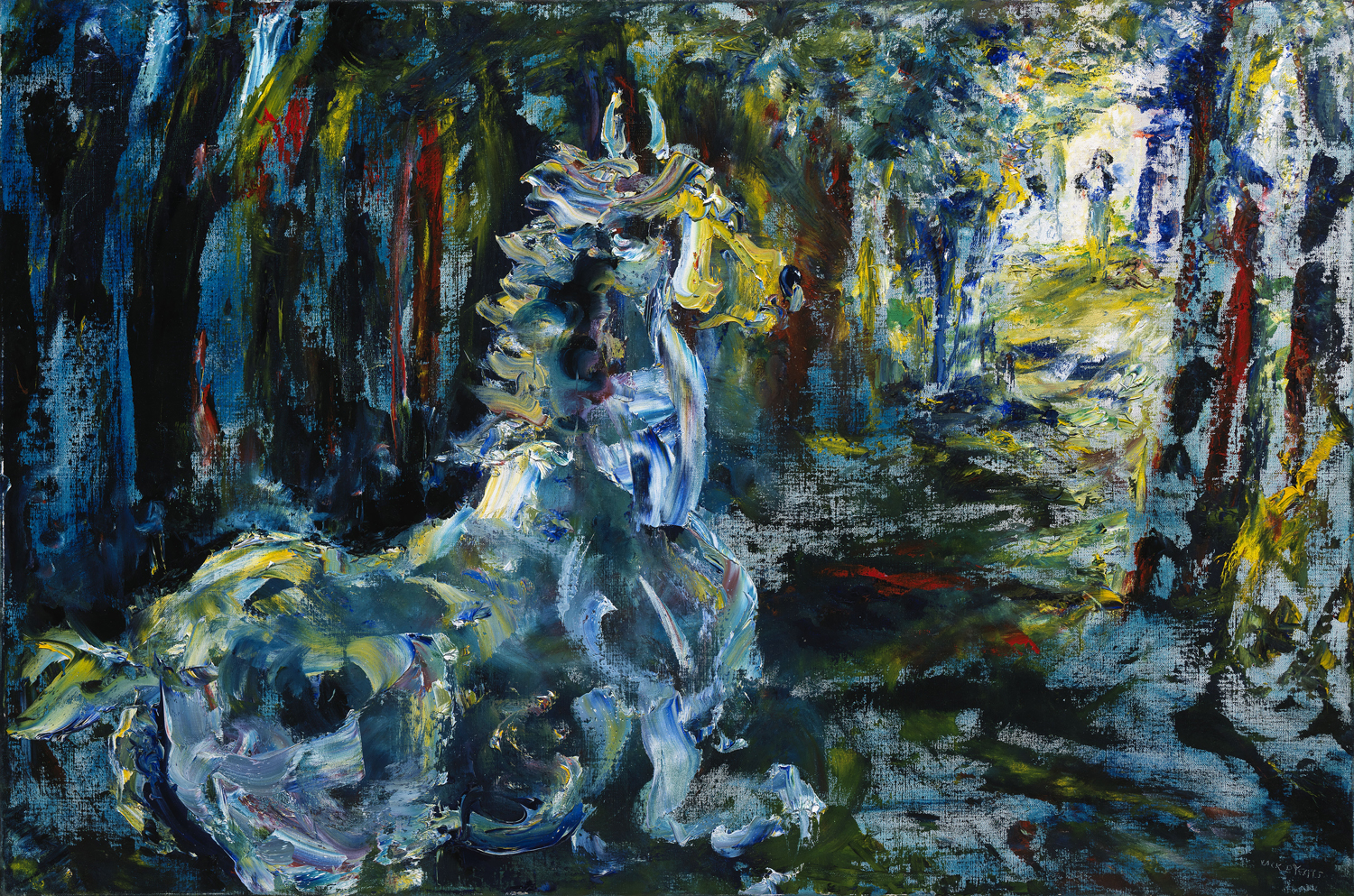 Jack B. Yeats (1871-1957), 'For the Road', 1951. © National Gallery of Ireland.
Jack B. Yeats (1871-1957), 'For the Road', 1951. © National Gallery of Ireland.
Room 14
Jack B. Yeats, (1871-1957), For the Road, 1951
Some stories are open-ended, and allow us to find our own meanings.
Let’s ask ourselves some questions to discover the meaning of this artwork.
- Where do you think this story takes place?
- What’s that at the end of the tunnel? Is it a person?
- Do you think the horse and the person know each other? What is their relationship?
Yeats had great affection for horses and painted them throughout his career. This horse is painted with very unusual colours.
- What colours has he used?
- Why do you think Yeats choose these?
Yeats has put the oil paint on the canvas in lots of different ways. He applies different thicknesses of paint and he makes marks in different directions to describe movement in the artwork.
- Do you think Yeats painted this quickly or slowly?
- How fast do you think the horse is moving?
Yeats expresses emotions through light, colour and the marks he makes.
- What is the feeling or atmosphere of the painting like?
- What colours can you see? Do you think they make an exciting mood?
- There is a light part and a dark part of the painting, what do you think this symbolises?
- What meaning or message do you think Yeats is trying to explain with this painting?
In the Gallery or at home
- Look around the room, each painting was done by Yeats. Can you spot any horses?
- Search for Jack B. Yeats in the Gallery’s online collection to have a look at the different ways he has painted horses over his career.
Explore further
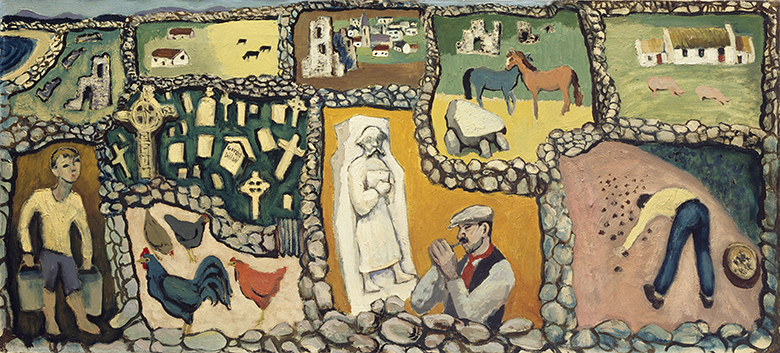 Gerard Dillon (1916-1971), The Little Green Fields, c.1946-1950. © The Estate of Gerard Dillon
Gerard Dillon (1916-1971), The Little Green Fields, c.1946-1950. © The Estate of Gerard Dillon
Room 1
Gerard Dillon (1916-1971), The Little Green Fields, c.1946-1950
We can make stories from everyday life too! The Little Green Fields tells the story of ordinary life in the west of Ireland in the 1940s.
- What do you think of this painting?
The artist Gerard Dillon was born in Belfast but started taking regular trips to the west of Ireland from 1939. He loved the rocky landscape of Connemara and the way that people lived and worked there.
- Can you describe what types of work the locals had to do in this painting?
- What animals can you see?
- What do you feel are the differences between being in a city or in the countryside? Do you prefer one or the other?
He was inspired by early Christian Irish artefacts. Christianity was introduced to Ireland in the early 5th Century from Roman Britain, this brought new influences and skills to Ireland. Stone carvers from this time were particularly skilled craftsmen, they produced a series of carved high crosses.
- Can you spot a high cross in this painting? There is a big one on the left hand side.
Dillon has included lots of references to early Christian life in Ireland. As well as the high cross in the graveyard, there is a sculpture of a monk and in the background there are ruins of an abbey.
This painting almost looks like it was done from above! Dillon uses thick and bold outlines to draw with and he doesn’t use very much shading which makes the figures look flat. Does it remind you of anything? A comic strip, perhaps?
In the Gallery or at home
- Dillon takes a view looking downwards to make his painting, try make a bird’s eye map of your journey through the gallery!
- You can include your favourite paintings!
- At home you can draw a map of your home!
Explore further
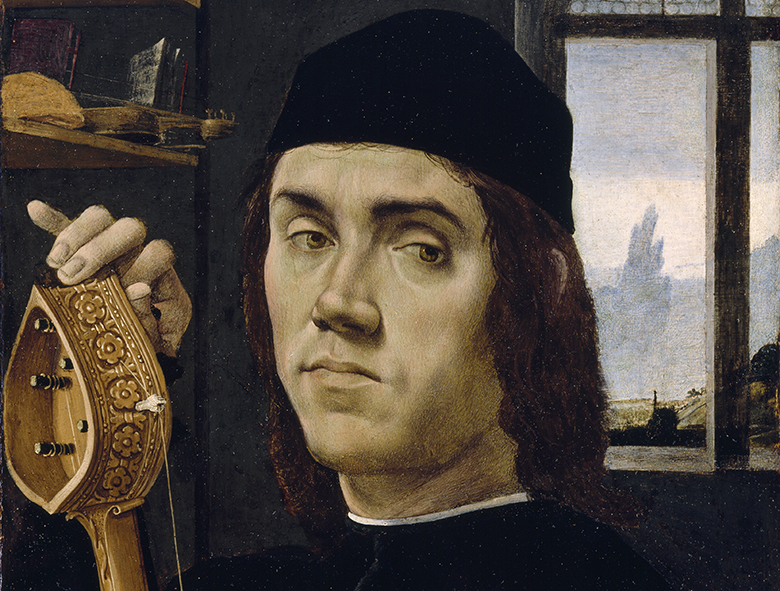 Detail from Filippino Lippi's Portrait of a Musician, late 1480s. Image © National Gallery of Ireland
Detail from Filippino Lippi's Portrait of a Musician, late 1480s. Image © National Gallery of Ireland
Room 30
Filippino Lippi (c.1457-1504), Portrait of a Musician, late 1480s
The artist has hidden a message in this painting! It might tell us more about the story.
- Can you spot it?
The musician holds a string instrument called a lira da braccio. This instrument was often played alongside poetry performances. There is an inscription on the back of it! It is taken from a canzona (a love song) it says: ‘il chomîcar nõ ?a p tempo mai’ this translates to ‘never start before the time’.
- What do you think this advice means?
- Do you think it’s a good idea to start something before you’re ready?
- What advice would you like to give someone?
This painting is from a period in history call the Renaissance. “Renaissance” is a French word meaning rebirth, it describes the great rebirth of art that took place in Italy between the 14th and 16th centuries. There was rediscovery of ancient art and culture which inspired artists and architects of the time. Music was really important in Renaissance life, too.
We don’t know who this man is, but his dark clothes suggest that he is a professional court musician and composer. His bow is resting on his arm while he tunes his instrument.
- Can you spot any other musical objects in the paintings?
- On the shelves to the left are books, a lute, a second lira and two recorders.
- Do you think his body language tells us that he is used to playing often?
Explore further
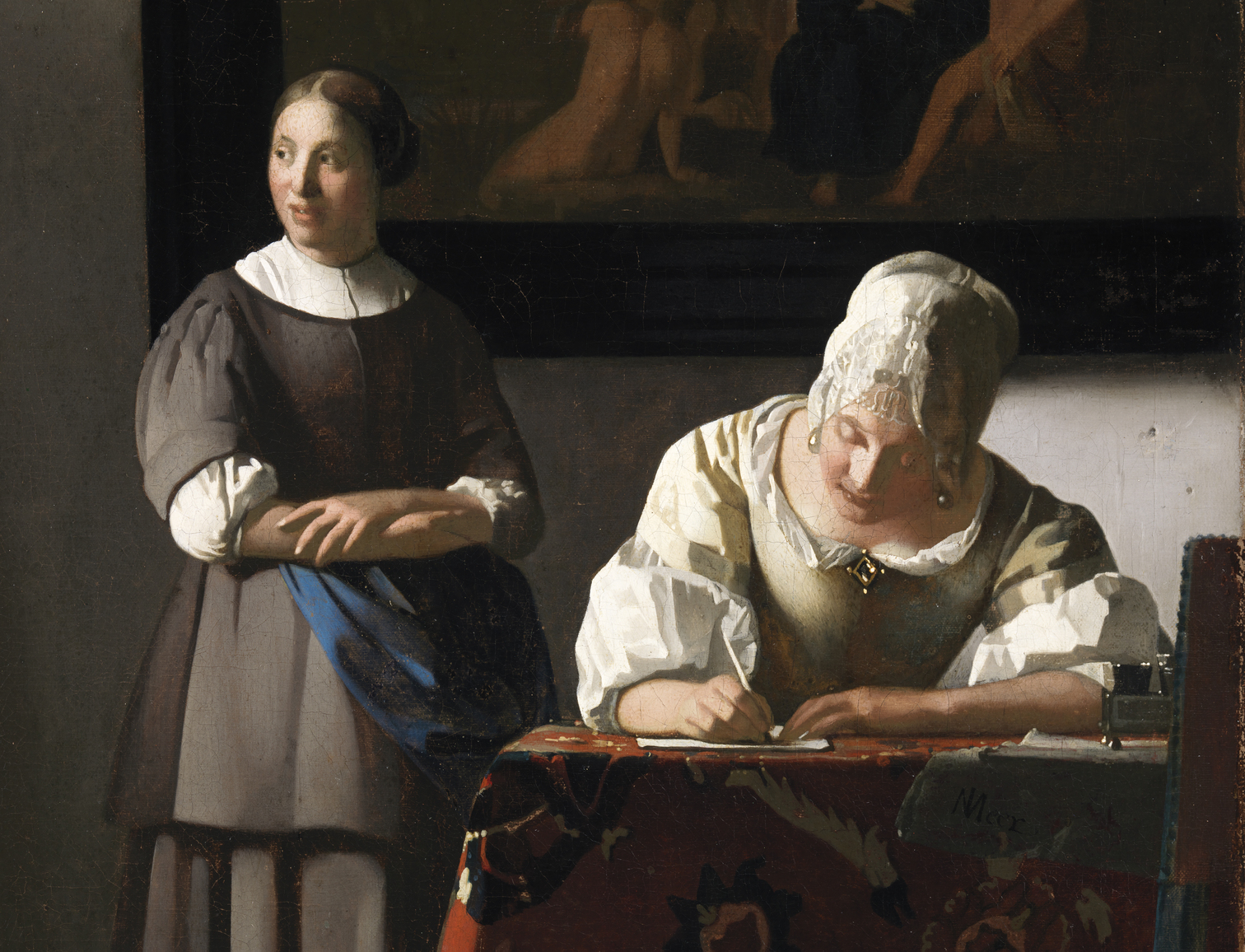 Johannes Vermeer (1632-1675), 'Woman Writing a Letter, with her Maid', c.1670. Image © National Gallery of Ireland
Johannes Vermeer (1632-1675), 'Woman Writing a Letter, with her Maid', c.1670. Image © National Gallery of Ireland
Room 38
Johannes Vermeer (1632-1675), Woman Writing a Letter, with her Maid, c.1670
This painting shows a woman writing a letter. At first glance it appears simple, but it can uncover a hidden story.
- Who do you think she is writing to?
Most of the artist Vermeer’s paintings show women in homes doing everyday activities. Only about 36 of his artworks have survived!
- There are two women in this painting, how do you think they know each other?
- How are their clothes different? What do you think this can tell us about the story?
Artists use body language and facial expressions to tell us about how the figures in paintings are feeling.
- You could try to pose like these figures.
- How do you think they feel?
- What do you think the maid is waiting for? Could it be someone returning?
- What do you think the woman is writing? Do you think it is good or bad news?
There are some clues on the black and white tiles that might tell us more!
- Can you spot a red seal, a stick of sealing wax and crumpled paper?
- How did they get on the floor?
- There is an empty chair at the table, who might sit there?
Can you see the two curtains in this painting? Only one of them is for the window. Vermeer has painted a second green curtain to make it feel like we have pulled the curtain back on this story and we are peeking in!
In the Gallery or at home
Comic strips use thought bubbles to let us know what the characters are thinking. You could create a comic strip based on this story!
- First, think about how many drawings you will make to tell the story.
- Will you start your comic with what happened just before the woman started writing? Will you include what might be happening through the window?
- Next, divide a page into that number of boxes.
- Then, start drawing your story!
Explore further
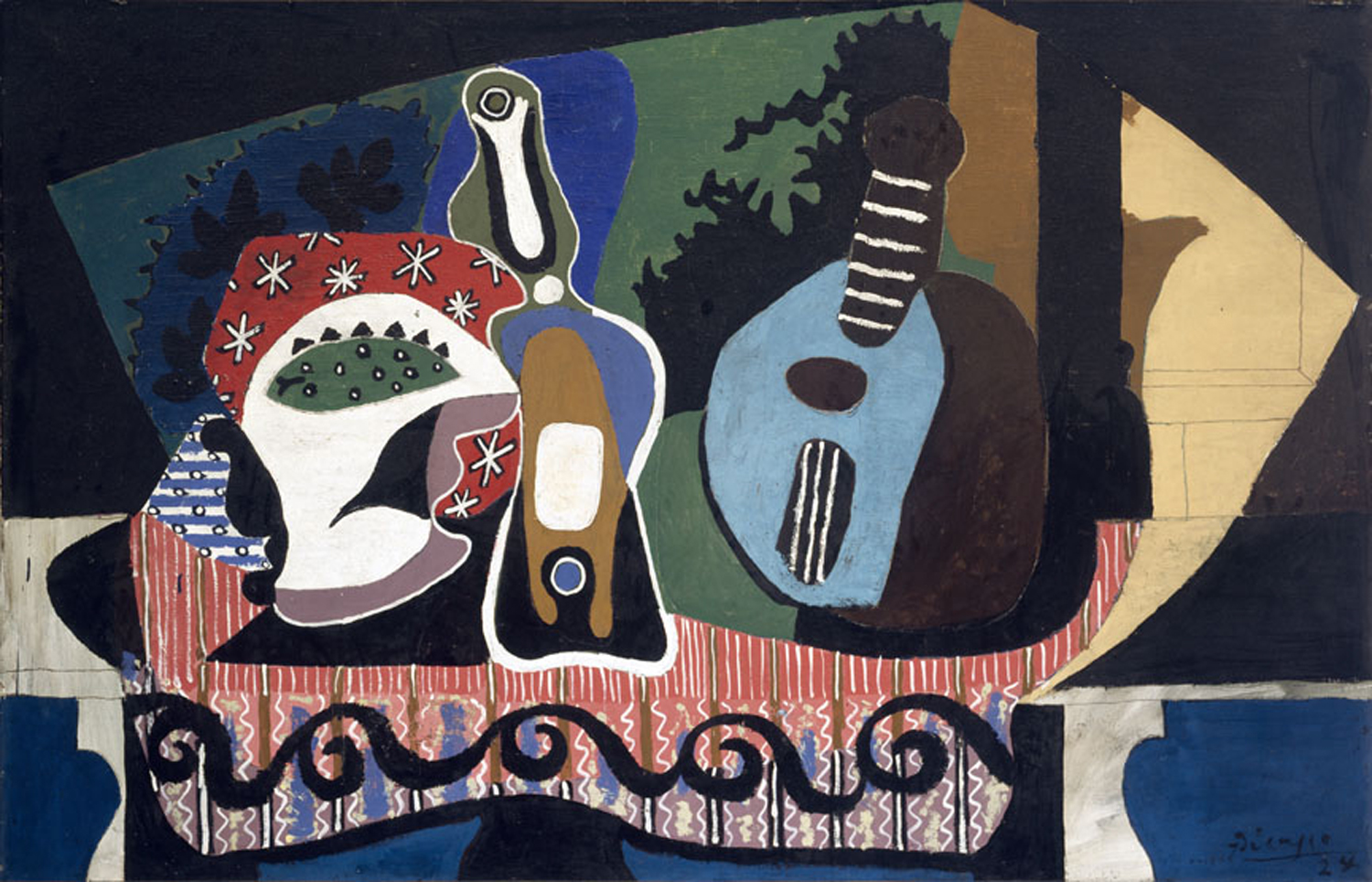 Pablo Picasso (1881-1973), Still Life with a Mandolin, 1924. © Succession Picasso/DACS, London 2020
Pablo Picasso (1881-1973), Still Life with a Mandolin, 1924. © Succession Picasso/DACS, London 2020
Room 1
Pablo Picasso (1881-1973), Still Life with a Mandolin, 1924
Artists tell stories through the objects they choose to include in their artworks. This type of painting is called a still life. A still life is where you arrange objects and make a painting or drawing from them.
- There are three objects in the centre of the painting, can you guess what they are?
The artist Pablo Picasso has painted a white fruit dish, a wine bottle and mandolin! A mandolin is a musical instrument, with a pear-shaped body, it is in the same family of instruments as a guitar but a mandolin has four to six pairs of strings.
- It seems like there could be a party happening!
- Do you think the mandolin would work well? Why not?
- Can you guess what type of green fruit is inside the fruit bowl?
Pablo Picasso was one of the most influential artists of the twentieth century. He created paintings, sculptures, illustrations, prints and ceramics. Picasso was born in Spain and moved to Paris in 1904. He worked in France for most of his life. Picasso and fellow artist Georges Braque are well known for creating and developing the style of art known as Cubism.
Cubism is when you show lots of different viewpoints of an object all at once! If you look at the wine bottle you can see the hole at the top like you are looking down into it, you can see the circle on the bottle like you are looking up at it and you can see the label on the front like you are looking straight at it.
Picasso painted this work at the seaside of southeast France, where he painted a series of works. He puts strong colours side by side to make the painting feel lively and exciting.
- There are black wave-like swirls across the bottom of the painting, what do they remind you of?
- Do you think this painting is set during the day or night time?
- What can you see in the background of the painting?
At home
- Can you make a still life with objects that tell a story about you?
- How will you arrange your still life, could you put some colourful fabric under it like Picasso?
- Make a painting or draw your still life! You can even take a photo of it!
Explore further
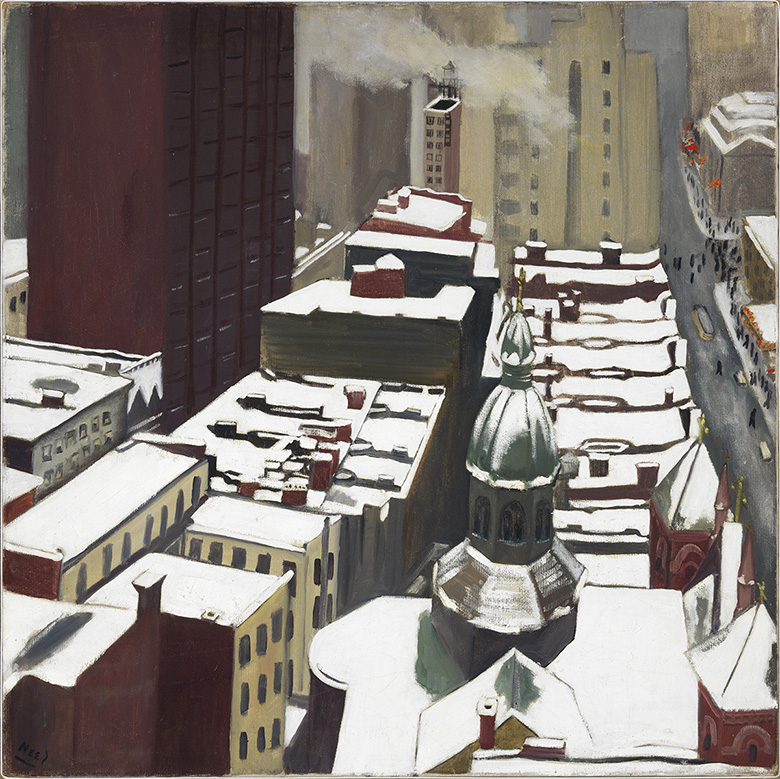 Alice Neel (1900-1984), Cityscape, 1934. © The artist's estate.
Alice Neel (1900-1984), Cityscape, 1934. © The artist's estate.
Room 1
Alice Neel, Cityscape, 1934
What hidden stories are happening in our cities?!
- What can you see in this painting?
- Can you tell which season it is?
- What feeling does this painting give you? Why?
The artist, Alice Neel is most known for painting people up close. To really show their personalities and lives Neel tried to connect personally with the people she painted.
- Can you see any people in the painting? Neel has painted them as black lines in the distance on the grey street.
- Do you think she feels connected to them?
- Where are the people going? Look at the little red dots, they are the lights outside theatres.
- What sounds do you think are happening below on the street?
Neel painted this after a difficult time in her life, when Kenneth Dolittle, who she lived with at the time, destroyed around 60 of her paintings, and over 200 drawings & watercolours. This left Neel extremely frightened but this painting marks a new beginning in her life.
A ‘composition’ is a word to describe how an artist arranges all the different things in an artwork.
- What is in this composition? Can you spot lots of tall buildings?
- How has the artist arranged them, has she put lots of space between them or are they tightly packed?
- How do you think it would feel to wander around these buildings?
In the Gallery
Alice Neel created this artwork by looking out from a window in a hotel room in New York City, let’s try to make our own in Dublin!
- First get paper and something to draw with. You can borrow family packs, which contain paper and drawing materials, from the information desks. It’s free to borrow them.
- Find a window in the Gallery, there is a big one in Room 5!
- Look carefully out the window, can you see buildings and people walking around?
- Do you notice that the buildings that are faraway look as though they are smaller?
- Make a drawing of what you can see. Remember that Neel chose not to show the tops of some of the tall buildings! Will you do the same?
At home
Make your own snowy scene like Alice Neel!
- First, with help from an adult find some flour and paper.
- Next find a surface you can get messy, like a table.
- Then cut or tear lots of long strips of paper.
- Using Neel’s Cityscape as inspiration place down the strips of paper to make the outlines of the buildings.
- Lightly sprinkle the flour over the whole surface.
- Carefully remove the strips of paper to reveal your snowy city!
- You can use your finger or the back of a pencil to draw in more details into the flour, like windows.
- Finally, don’t forget to clean up!
Explore further
You might also like:
-

Through a Lens tour: Babies & Toddlers
An online self-guided tour to engage babies and toddlers
-

Through a Lens: Family Architecture
A special tour for Open House 2020
-

Through a Lens: Self-guided tours of the collection
Discover the collection with these online self-guided tours
